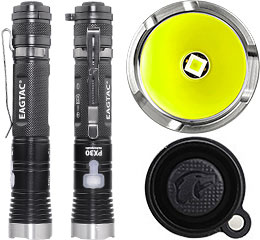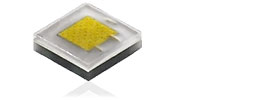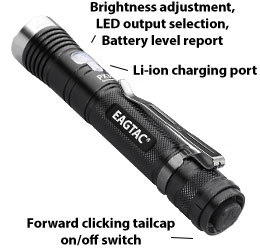Dimensions
- Head Dia.
- 1 inches (25.4 mm)
- Body Dia.
- 0.85 inches (22 mm)
- Length:
- 5.4 inches (137 mm)
- Weight
- 2.4 ounces (70 grams)
w/o battery - 4.2 ounces (120 grams)
w/ battery

Battery Type
- 1x18650 or 2xCR123A2
- The built-in li-ion rechargeable function only works with a single 18650 battery
- Compatible battery (diameter/length)
- 123A: (16-16.8mm/34-34.5mm)
- 18650: (18-18.8mm/67-68.5mm)
- Read precaution with li-ion batteries.
Operating voltage
- 2.7V - 6V All batteries are connected in series. Do not exceed 6V. Do not use two rechargeable 3.0/3.7V RCR123A.
What's included
- PX30LC2-R flashlight
- Spare o-rings
- User Manual
- Mil-Spec Para-cord Lanyard w/ quick attachment clip
- Comes with stainless steel bezel
- USB charging cable (3.3feet/1meter)
w/ AWG24 copper wire - EAGTAC 18650 Li-ion battery included
Two models
- Base
- Smooth stainless steel bezel
- Removeable silver pocket clip made of spring steel w/ harden treatment
- EAGTAC 18650 2600mAh li-ion battery (8A High discharge protection pcb built-in at anode)
- Kit
- Crenulated stainless steel bezel
- Removeable darken pocket clip made of spring steel w/ harden treatment
- EAGTAC li-ion 18650 3500mAh battery (authentic Sanyo Japan cell)
- UL certified USB 5V 1A wall charger (100V-240V)
- Heavy duty nylon holster
Carrying method
- Para-cord lanyard with quick attachment clip
- Heavy duty nylon holster
Waterproof
- IPX-8 standard
Replaceable items
- Lens
Reflector
- Light textured aluminum reflector
Material
- HAIII hard anodization aerospace aluminum
LED
- CREE XP-L HI V3 Cool White LED
- CREE XP-L HI V2 Neutral White LED

Max output
- CREE XP-L HI V3 Cool White LED
- LED lumen: 1160
- ANSI FL-14 lumen: 950
- Nichia 219C CRI92 R9050 SW40 4000K D240 LED
- LED lumen: 800
- ANSI FL-14 lumen: 645
Beam Profile
CREE XP-L HI V3 Cool White LED- Center lux: 25,100 lux
- Center spot angle: x°
- Spill light angle: x°
- Beam distance: 345 yards / 317 meters
- Center lux: 12,200 lux
- Center spot angle: x°
- Spill light angle: x°
- Beam distance: 241 yards / 221 meters
Lens
- Waterwhite glass lens w/ harden treatment
- Anti-reflective (A.R.) coating on both side (96% transparency)
- Multi-layers low color distortation A.R. coating on both side (98% transparency) to prevent reflections and color shadow over wider wavelength - Nichia 219 CRI92 only
LED circuit
- C3200L SC
- Ultra low dropout voltage (<0.2v) for longer current regulated runtime
- Highly integrated design w/ built-in side click switch
- Low internal resistance design offers up to 99% efficiency
- High switching frequency (1MHz) controller for more compact circuitry design
- Non-dimming constant current regulation for all output levels without flicking
- Smart battery level report system
- Energy saving feature5
- Zero standby current
Charging circuit
- L950 SC
- 5V USB input (requires 1A or higher)
- 950mA MAX charging current
- Constant current / Constant voltage charging algorithm
- Small current charging for low voltage battery (less than 3.0V)
- Precise voltage detection design +/- 1%
- No trickle charge
- Smart charging level report system
Battery level report (discharging)
- A blue LED indicator under the main switch reports the estimated battery remaining capacity
- Flash once: lower than 20%
- Flash twice: 20%-50%
- Flash 3 times: 50%-80%
- Flash 4 times: higher than 80%
Charging level report (charging)
- A blue LED indicator under the main switch reports current charging level
- Flash once: lower than 50%
- Flash twice: 50%-75%
- Flash 3 times: >75%
- Constant on: 100% (done)
Output and Runtime
- Five brightness levels
- Led lumen:
11605-980/590/221/77/9 - ANSI FL-1 lumen:
9505-810/480/180/64/7 - Runtime: 1.5/2.8/8.5/28/200+ hours (1x18650) 6
- Three hidden auxiliary outputs7
- Disorienting Strobe/Beacon (1.67Hz)/S.O.S.
0.8/1.5/5/17/140 hours (2xCR123A)
Operations
Basic operations:- Turn on the light at MAX output by pressing the tailcap button until it clicks.
- Turn on the light at LOW output by holding the side switch button while pressing the tailcap button until it clicks.
- For momentary on function, slightly press the tailcap button
- To switch between different brightness levels, press the side button switch w/ flashlight on
- To enter hidden auxiliary mode, press and hold the side button switch for 3 seconds w/ flashlight on


Battery charging:
- Remove the waterproof cover and insert the charging cable to charge the battery. User must turn on the flashlight switch at the tailcap to charge.
(The flashlight will switch off the LED output during charge automatically until the charging cable is disconnected.) - The indicator may start flashing when user plug in the charging cable (without turning on the tailacp switch). Switch on the tailcap switch to start charging and the charging indicator will reflect the current charging level.
Controls

Other features
- LED direct soldering on copper for maximum heatsink ability
- User replaceable glass lens
- Battery reverse polarity protection
- Ultra low internal resistance phosphor bronze springs (silver coated)
- Spring loaded positive and negative terminal
- Bi-directional pocket clip design
- Built-in li-ion charger
Warranty
- Ten years performance guaranteed warranty
- Read flashlight regular maintenance
Battery Safety Precaution
Ensure the protective circuit on the 18650 batteries has current limitation of higher than 5A. Always use proven EAGTAC batteries for best performance and reliability.All EAGTAC flashlights are designed to use button-top battery (battery with protruding positive terminal). For rechargeable li-ion battery, use only EAGTAC li-ion battery, or other protected li-ion battery with compatible length and diameter. Before using the battery, check and ensure the battery outer wrapping (the isolating plastic film that wraps around the metal housing of the battery) is complete. Broken battery wrapping may lead to short circuit and damage to the flashlight.
Lithium and Li-ion battery can explode or cause burns if disassembled, shorted, or exposed to high temperature. Do not mix new and used batteries. Do not mix batteries with different brand, capacity, voltage, or install batteries backwards.
NiMH rechargeable battery may release gas during discharge. If you experience an inflated switch boot or find high pressure being built inside the flashlight, switch off the flashlight immediately. Slowly loosen the tail-cap to reduce the internal pressure and replace all batteries. Back to top
Flashlight Maintenance
Periodically clean the threads and o-rings with a lint free cloth and apply a thin coating of EAGTAC synthetic grease to the o-rings and threads. After prolonged exposure to moisture, the head and batteries should be removed, inspected, and dried. Do not touch or attempt to clean the reflector, as it will scratch the reflective coating permanently. Back to topAccessories

CR123A Lithium Battery
EAGTAC CR123A high performance lithium battery. 1500mAh capacity. PTC protected.

LED upgrade module
Upgrade to XM-L2, XP-G, Color, UV 365nm-370nm, 395nm-400nm, IR 850nm.

18650 Li-ion Battery
EAGTAC 18650 high performance li-ion rechargeable battery. 3100mAh capacity. IC protected. Japanese made cells.

Diffuser/color filters
Add-on diffuser filter to transform into a flood beam. Choose from red, yellow, green, blue color filter.
- This weight measurement is based on the Kit model excluding batteries
- All batteries must have protruding top button.
- Beam output diameter taken at one meter
- ANSI FL-1 Lumens is a measurement of light output standardized by American National Standards Institute for use with flashlights. This ANSI Lumen measurement is the total overall light output being emitted from the flashlight. This measurement is generally more accurate as it takes into consideration the loss from reflector/lens/bezel. EAGTAC’s ANSI Lumen output is measured using a calibrated integrated sphere three minutes after turning on the flashlight. For O.T.F. lumen, measurement is taken one minute after turning on the flashlight.
- Energy saving feature reduce the maximum output current from 100% to 85% after 200 seconds at turbo output.
- Runtime is measured using three EAGTAC 3500mAh high discharge 18650 li-ion batteries.
- Maximum efficiency occurs when input voltage is very close to LED forward voltage.
- Details and feature maybe subject to change without notice.